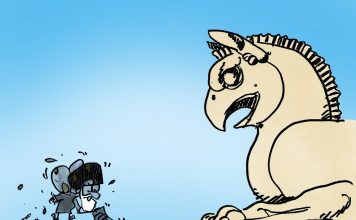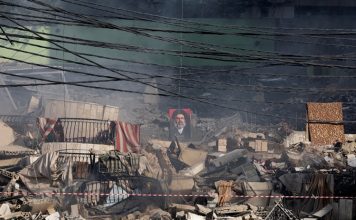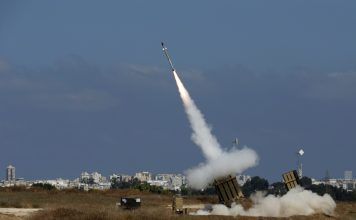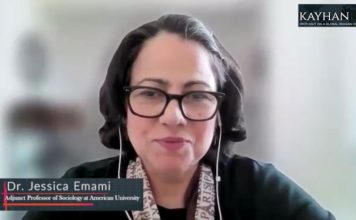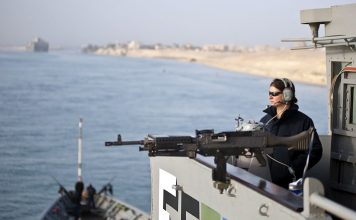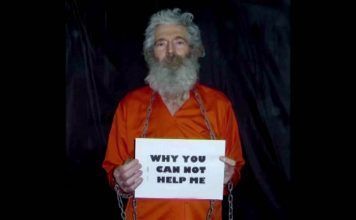
By Ahmad Rafat
Israel’s killing of Hassan Nasrallah, the Secretary General of Lebanon’s Hezbollah, has dealt a significant blow to the so-called “Axis of Resistance,” which was established by the Islamic Republic of Iran in the region. Hezbollah is a vital ally for Iran in its endeavors to challenge Israel and exert pressure on the U.S. and Western countries.
Hezbollah is a military-political entity that has been involved in many armed conflicts and plays an important role in Lebanese politics. Over the last 20 years, it has become one of the critical tools used by Iran in its regional strategy.
However, with the removal of Hezbollah’s political and military leadership occurring within a few weeks, the Islamic Republic now faces a new crisis.
It is essential to emphasize the difference between Hezbollah in Lebanon and other groups that are part of the “Axis of Resistance,” a term frequently used to refer to various militant organizations that align with Iran’s strategic interests in the region.
Hezbollah will be defeated. The Islamic regime in Iran will also be defeated.
The Iranian people, and all those in the region who seek peace, will emerge victorious. https://t.co/I0Q3wHVqsZ
— Reza Pahlavi (@PahlaviReza) September 28, 2024
Unlike these other groups, which have joined this coalition, Hezbollah is not merely a participant: It is one of the founding entities alongside the Qods Force (QF), the extraterritorial arm of the Islamic Revolutionary Guard Corps (IRGC.)
The origins of Hezbollah can be traced back to 1982 when several discontented members of the Amal Movement — a prominent Lebanese Shiite organization — met at the office of Ali Akbar Mohtashamipur, who was then serving as the ambassador of Iran in Syria.
These individuals sought to create a new political party that would embody and promote the revolutionary principles established by Ruhollah Khomeini, the founder of the Islamic Republic.
They perceived that the Amal Movement, founded by Musa Sadr (a Shiite cleric with Iranian roots), was insufficiently revolutionary and did not align closely enough with Khomeini’s vision for an Islamic revolution.
At the gathering in Damascus, multiple IRGC commanders were reportedly present, alongside three Lebanese Shia clerics: Seyyed Abbas al-Mousavi, Sheikh Hassan Fazlullah, and Sheikh Sobhi al-Tafily.
Hezbollah was established under the influence of Khomeini’s Islamic ideology.
From its inception, with the help of the IRGC, its members received military training and armaments provided by Iran.
Initially, Hezbollah outlined three primary objectives: to eliminate Western influence and culture in Lebanon, to challenge Christian and Sunni factions within the country, and ultimately to create an Islamic government.
However, a few years later, there were shifts in the party’s policies.
Through its political and military divisions, Hezbollah has moved away from the goal of transforming Lebanon into a state modeled after the Islamic Republic. Instead, it has sought to forge alliances with certain Christian groups, aiming to position them as allies of the Islamic Republic. Many see this tactical decision as a signal of potential conflict with Israel.
In this context, Hezbollah, alongside the IRGC’s Qods Force (IRGC-QF), has played a significant role in rallying other regional military factions to join the Axis of Resistance.
Hezbollah has been closely involved in establishing the Popular Mobilization Forces (PMF) in Iraq. The QF has transferred the responsibility for organizing the PMF in Iraq, which encompasses extremist Shia factions, to Sheikh Mohammad Hussein Al-Kawtharani, who is a member of Hezbollah’s leadership.
ANALYSIS: Islamic Republic-Backed Hezbollah: What Weapons Does It Have?
Also, the Islamic Republic has tasked Hezbollah with fostering relationships with Hamas in Gaza. The group has been instrumental in training Ansar Allah (Partisans of God), which includes the Yemeni Houthis. In Syria, Hezbollah fighters maintain a military presence to support President Bashar al-Assad’s regime.
Understanding Hezbollah’s significance within the Islamic Republic’s regional strategy is crucial. It highlights Hezbollah’s vital role in establishing the “Axis of Resistance.” However, it is important to note that Hezbollah could only have functioned effectively with the Islamic Republic’s financial backing.
The recent military actions by Israel against Hezbollah in Lebanon, which resulted in the death of Hassan Nasrallah, place the Islamic Republic in a precarious position.
The assassination of Nasrallah will exacerbate the internal turmoil within Hezbollah, which had already begun prior to Oct. 7 and the Hamas’ attack on Israel. This crisis has intensified since then, and revitalizing the organization — especially after losing twenty key military leaders in recent weeks — will be challenging.
Nasrallah successfully united three factions within Hezbollah, preventing any divisions among them.
One segment of Hezbollah believes that this organization, which has representation in the parliament and government of Lebanon, should not confine its actions solely to execute directives from Tehran. Instead, it should prioritize Lebanon’s national interests equally, if not more so than those of the Islamic Republic.
This perspective is supported by notable figures such as Sheikh Mohammad Yazbek, who leads the Sharia (religious) Council, and Ibrahim Amin Al-Sayyed, who heads the Hezbollah Political Council.
Following the assassination of Ismail Haniyeh, the Hamas leader, on July 31 in Tehran, there has been a noticeable lack of response from the Islamic Republic. This silence has prompted some individuals to express their discontent with the Islamic Republic’s policies publicly. These critics, including factions within Hezbollah in Lebanon, are vocal about their opposition to Tehran’s “strategic patience” approach.
They are urging the Islamic Republic to engage directly in conflict with Israel rather than relying on proxy forces to respond to military actions taken by Israeli Prime Minister Benjamin Netanyahu’s administration.
A senior member of Hezbollah, who requested anonymity because of the sensitive nature of the current situation, told Kayhan Life that while the Islamic Republic is pursuing negotiations with the U.S. and Western powers, those on the ground are left mourning leaders killed by Israel — with support from those very Western powers.
The person emphasized that for the Islamic Republic, they are perceived merely as expendable tools that could be sacrificed at any moment.
Sheikh Sobhi al-Tafily, a founding member of Lebanon’s Hezbollah and its first secretary general, who distanced himself from the Islamic Republic many years ago, has criticized the lack of response from the Islamic Republic the recent assassinations of Hezbollah leaders and mid-level officials, as well as the Gaza conflict and the assassination of Haniyeh.
Sobhi Al-Tafily labeled this inaction as “treason” and “collaboration with Israel,” calling for the trial and execution of Iran’s Supreme Leader Ali Khamenei.
In previous instances, Hezbollah has successfully navigated crises following the assassination of its commanders and has continued its military operations.
However, Hezbollah cannot revert to its previous operations following the assassination of Nasrallah. This event not only brought humiliation to both Hezbollah and the Islamic Republic but also significantly altered the dynamics at play, plunging this military-political organization into a crisis from which it may not recover.
The question today is not when and how Hezbollah will revert to its previous state. Instead, the pressing inquiry is whether Hezbollah can sustain its existence, and if it can, what form will it take in the future? Will it be capable of maintaining two distinct entities — one military focused solely on conflict with Israel and another political entity engaged in Lebanon’s parliament and government? Or will it be compelled to sacrifice one of these structures for the survival of the other?
To find answers to these questions, we must await the appointment of Nasrallah’s successor.
Three individuals are being considered, although a different candidate may be selected. The leading contenders are Hashim Safi Al-Din, Naim Qassem, and Sheikh Mohammad Yazbek. Among these, Hashim Safi Al-Din appears to have the backing of the Islamic Republic. He is a maternal cousin of Hassan Nasrallah and the father of Zeinab, who is married to the late Lieutenant General Ghasem Soleimani’s son.
Soleimani, the former commander of the IRGC-QF, was killed in a U.S. drone strike at Baghdad International Airport in January 2020.
Safi Al Din’s brother currently serves as Hezbollah’s representative in Tehran.
Naim Qassem, who has served as the deputy secretary general of Hezbollah for many years, has little support because of his leftist background.
The election of Sheikh Mohammad Yazbek could enhance Hezbollah’s influence as a political entity in Lebanon.
A decrease in Hezbollah’s military capabilities within Lebanon might lead to divisions within the organization. Approximately 25,000 members of this group could align with other military and terrorist factions active in southern Lebanon to preserve their status and the benefits they receive from the Islamic Republic.
Among these active militia groups in southern Lebanon are the “Imam Hossein Division,” which collaborates closely with Hezbollah, and the “Tornado Eagles,” which serve as the military wing of the Syrian Social Nationalist Party, both of which are sustained by their anti-Israel ideology.

